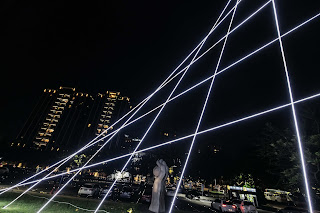媒材: 鐵架、鋼索、LED燈條、微型控制電子元件
Material: Iron frames, wire, LED strip, microcontroller.
尺寸因場地而異 / Dimension Variable.
重量/ Weight: 150kg.
(攝影:汪正翔)
| 「非歐幾何延伸公設」是一個戶外的裝置藝術。觀眾可以看到在國立台灣美術館的建築切角上,有一個由許多直線條所構成的一個類拋物線的曲線。當觀眾進入到作品接近地板的位置,會觸發燈光從地面逐漸延伸到垂直立面上。 在數學上的定義中,基於點線面公設,歐幾里得幾何指的是二維平面和三維空間中的幾何。而公設(Axiom)的意思則是代表在傳統邏輯中,是沒有經過證明,但被當作不證自明的一個命題。 公設另外一個層面也取名於公共設施的簡寫,對於意義上的解讀藝術家從原先建築附著於新的結構,產生公共設施在觀賞上的機轉。藝術家這次在國立台灣美術建築空間中,試圖對於想像中的直角做非傳統意義空間上的延伸,建立一個從不同視角觀看,可以感受到不同平面建立的可能,基於幾何學的範疇創造出一個新的感知空間。 "Non-Euclidean Geometry" is an outdoor installation art piece. Viewers can see a parabola-like curve made up of many straight lines at the cut-off corners of the National Taiwan Museum of Fine Arts building. When the viewer moves close to the floor level of the artwork, it triggers lights that gradually extend from the ground to the vertical surface. In mathematical definitions, based on the postulate of points, lines, and planes, Euclidean geometry refers to geometry in two-dimensional planes and three-dimensional spaces. An axiom, on the other hand, represents a proposition that is considered self-evident in traditional logic, without requiring proof. Axiom, in another context, is also a shorthand for public facilities, which provides another layer of meaning. The artist has attached new structures to the original architecture, creating a mechanism for public facilities to be appreciated. In this space of the National Taiwan Museum of Fine Arts, the artist attempts to extend the traditionally conceived right angle into non-traditional spatial meanings, establishing a perceptual space where viewers can sense different planar possibilities from different perspectives, creating a new perceptual space based on the realm of geometry. |


